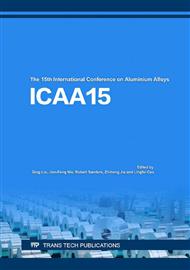p.593
p.601
p.606
p.611
p.617
p.625
p.635
p.640
p.647
Cold Stamping of 6061 Al Alloy Assisted by Arc Welding Pretreatment
Abstract:
Considering the poor plastic forming capacity of Al alloys at room temperature, this study proposed a stamping technique assisted by arc welding for partial material modification. The plastic forming capacity of the sheet pretreated by arc welding was confirmed with the V-shaped bending test. The microstructures and mechanical properties of the sheets were tested, and the cause of the increase in sheet deformability was analyzed. The Al alloy sheet pretreated by arc welding showed good plastic capacity at room temperature and under large deformations. The main advantage of arc welding is high speed, by which plastic working efficiency can be increased under certain conditions. In this technology, the difficult forming areas of structural parts are first located. Before plastic forming, sheets are pretreated by arc welding to convert the rolled grains in the softened heat-affected zones (HAZs) of the sheets into equiaxed grains and thereby regain grain deformability. Arc welding pretreatment is only used to soften difficult forming areas. Moreover, the local plasticity of sheets significantly increases in comparison with that of base metals, and the hardness of HAZs after plastic forming is improved.
Info:
Periodical:
Pages:
617-624
Citation:
Online since:
November 2016
Authors:
Keywords:
Price:
Сopyright:
© 2017 Trans Tech Publications Ltd. All Rights Reserved
Share:
Citation:


